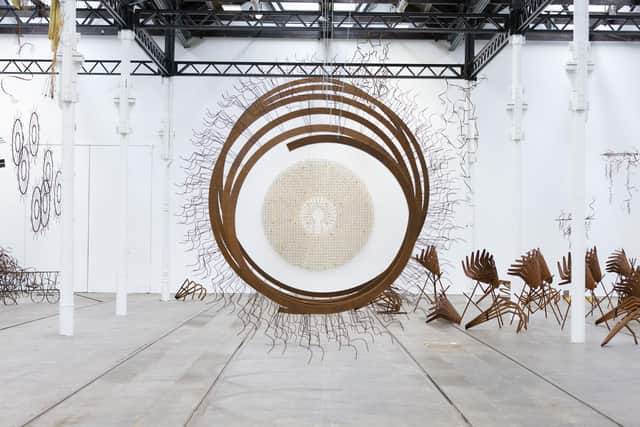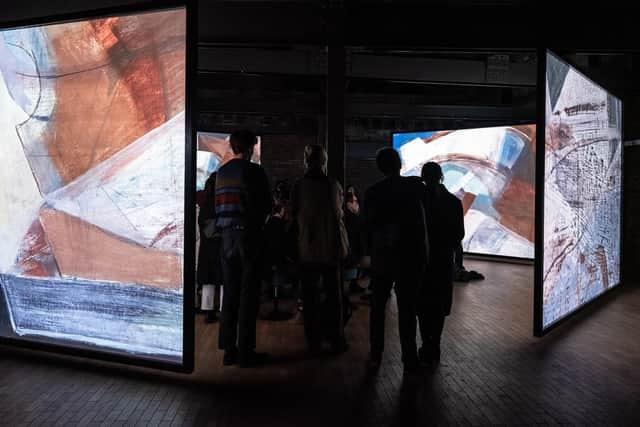Art reviews: Iza Tarasewicz | Hayley Tompkins | Mark Cousins
Iza Tarasewicz: The Rumble of a Tireless Land, Tramway, Glasgow ****
Hayley Tompkins: Far, Fruitmarket, Edinburgh ***
Mark Cousins: Like A Huge Scotland, Fruitmarket, Edinburgh ****


Advertisement
Hide AdRise of the Machines meets The Wicker Man in the work of Polish artist Iza Tarasewicz, who has filled the main gallery at Tramway with sculptures made from metal and wheat, inspired by obsolete farm machinery. In her lexicon of shapes, two of the most commonly used are a four-fingered metal claw and a tripod of legs topped with a fan of metal about the size of (and strangely evocative of) a turkey. A cluster of these gather around the door to Tramway 2 like poultry waiting to be fed, and the viewer must pick their way between them.
If this isn’t already unsettling, the largest work in the show is Momentum, a great spiral of metal suspended horizontally in the centre of the gallery covered with delicate hooks, which looks like it might turn into a spinning vortex at any moment and start sucking in everything in its path.
Another work, Ruins and Promises, has the body of a cart with a group of scythe-like bladed implements at one end and a pair of flat wings like those on a satellite. The one which best channels the folk horror vibe is one of the series called Cluster of Contingencies, a pyramidal frame made of wheat sheaves with large twisted fork heads springing out of it.
Other works tumble down from Tramway’s exposed beams, coil around its pillars or hang like mobiles or mechanical dreamcatchers. Some have a small square of intense yellow pigment beneath them on a bed of clay. They have been made with great delicacy and care, and the sculptural language has an impressive unity which builds cumulatively. At least it does up to a certain point, after which it starts to feel repetitive.


Tarasewicz is based on a farm in eastern Poland and is interested in agricultural labour, protest, community, the effects of industrialisation. She’s also interested in movement, and there have been dance performances in the space, which might help explain why everything feels like it could start to move at any moment. It’s true that the monstrous machines of today’s industrialised farming would trample these objects, so maybe there’s a bit of elegy too, but one can’t shake the feeling that they might come alive after dark and plot their revenge.
I can safely say no hairs on the back of my neck were raised by the Hayley Tompkins show at the Fruitmarket Gallery. Like many of Glasgow’s contemporary artists, she doesn’t often show in Scotland, and this is her biggest show here to date, bringing together work from the last 15 years.
Advertisement
Hide AdTompkins is primarily a painter and colour is important in all she does. This is useful information to take into the lower gallery where we find a collection of painted wooden chairs and five films, dating from 2007-2022, being shown on very small screens.
Labelling is sparse, at best, throughout this show and working out which film is which requires detective work. One focusses on images of designer brands in magazines, another on close-ups of pavements and flowers. One pans shakily over a computer keyboard. All contain some flashes of pure colour. Are they collections of inspiration, a way of working out ideas?


Advertisement
Hide AdUpstairs, there are paintings: two painted shirts from an earlier series, but mostly large upright acrylics. Tompkins paints on the floor, as Jackson Pollock did, and works across several paintings at once. Sometimes she hangs a work on the wall when the paint is still wet, allowing it to run down.
These works are abstract and seemingly entirely instinctive, without a trace of planning or structure (to which even Pollock conceded). They are about process, and how a moment in that process might be frozen in a “finished” work, but the artist seems actively to distance herself from any idea of intention, authority, even skill. They exist but they don’t communicate.
There are two works in the show which do more. One is the installation But I don’t even think it’s you, in the small room at the end of the lower gallery. Painted paper bags and a cardboard box become sculptural objects arranged on a bright yellow floor with a gravity which seems to belie the ordinariness of the materials. Upstairs, there is a mallett painted purple. The paint partly transforms it and partly doesn’t: it’s still a mallett, still resonating with the energy of destruction.
These works at least explore the idea of transformation, the juxtaposition of an object and idea. Elsewhere, Tompkins resists this, as she resists metaphor, or the sense that the art carries meaning. A chair is a chair, a shirt is a shirt. There is no magic. In that respect, she achieves what she has set out to do. A chair is a chair. But what’s interesting about that?
There is much more to draw the viewer in Fruitmarket’s warehouse space. In 1949, Wilhelmina Barns-Graham went to the Grindelwald glacier in Switzerland and it changed the way she made art. In this four-screen installation, filmmaker Mark Cousins (whose cinema documentary on Barns-Graham is due out next year) tries to get to the bottom of that moment. What, after all, is inspiration? What does an epiphany feel like?
Footage of the glacier today and of Barns-Graham’s paintings come together with an eight-channel soundscape by Ania Przygoda and music by Linda Buckley. There is a spare, insightful text, a dialogue between the younger Barns-Graham, who saw the glacier, and the artist 50 years on who remembers the moment vividly but still wonders why it changed her.
Advertisement
Hide AdIt wasn’t to do with the dramatic Alpine vista, she’s clear on that. It was about staring into the glacier itself, solid yet transparent, somehow alive. “I seemed to see my brain,” she says, “structures I’d long seen. I thought ‘My God, of course’.” “Describe it,” the younger woman says, and she answers: “I have. In my paintings.” The film ends with a shocking image of the glacier today, showing how much it has melted, and there is a small group of Barns-Graham’s paintings and drawings out in the corridor.
As installations go, it isn’t perfect. Seated between the four screens, unable to see all four at once, one is always missing something. But as one artist delving unashamedly into the work of another, trying to understand it, and maybe something about the artistic process in general, it is compelling. It doesn’t give easy answers, or explain what the art does, but it does much to illuminate the question.
Iza Tarasewicz: The Rumble of a Tireless Land and Hayley Tompkins: Far both until 29 January; Mark Cousins: Like A Huge Scotland until 27 November